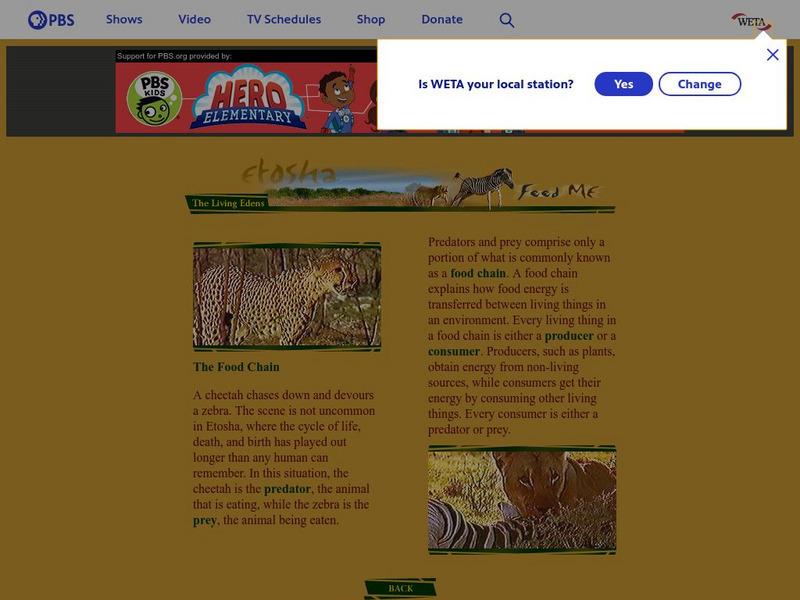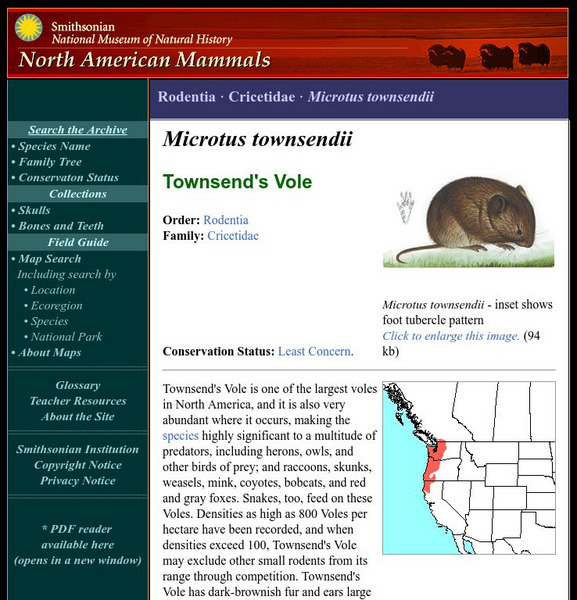PBS
Nh Pbs: Nature Works: Bony Fish
This site identifies different characteristics and information related to Bony Fish. Find out some fun facts about these friendly fish when you explore this site.
PBS
Pbs Teachers:how Can I Hide in Namib?
Identify how certain species survive in the Namib Desert through color protection, and determine what techniques animals in Namib use to hide from predators and to wait for prey.
Other
Zephyrus: Food Puzzle Chain
Answer these ten interactive questions about ecological feeding relationships by choosing the correct image that completes each food chain.
Project Britain
Primary Homework Help: Food Chains Quiz
Brush up on food chain vocabulary before taking this interactive quiz. Check the box for the correct answers throughout the assessment.
PBS
Pbs: The Living Edens: The Food Chain
PBS site provides some basic information on the food chain.
Other
Ohio Dept. Of Education: Our Grasslands
This excellent unit of study for Grade Two has students examining what makes up a grasslands environment, growing their own grass, playing a predator-prey game, and looking at how grasslands are impacted by human activities.
Better Lesson
Better Lesson: Survival of the Fittest
Fins, gills, claws, wings, each has a special purpose in helping an animal to survive. Students will look at how animals have different parts that help them to adapt to their habitat, and to avoid predators or capture prey. Included in...
Science Buddies
Science Buddies: Now You See It, Now You Don't! Test Your Peripheral Vision
The survival of our ancient ancestors depended on their ability to use peripheral vision to find prey and to avoid predators. Almost everything we do-from riding a bike, to dribbling a basketball, to reading a book-depends on peripheral...
BBC
Bbc Schools: Living Things: Food Chains Quiz
How are animals and plants linked? What is the difference between a producer and consumer? How is a predator different from prey? Take this food chain quiz to find out the answers to these questions and more. Links allow you to convert...
A-Z Animals
A Z Animals: Animal Facts: Siberian Tiger (Panthera Tigris Altaica)
Provides photographs and facts about the Siberian tiger. Discusses where they are found, predator-prey relationships, threats from humans, reproduction, and conservation status.
Science Education Resource Center at Carleton College
Serc: Bottle Biology
This activity book explores science and the environment through soda bottles and other recyclable materials. Sections include bottle basics, decomposition column, kimchee (fermentation), soil meditations, predator-prey column, TerrAqua...
Smithsonian Institution
National Museum of Natural History: American Mammals: Townsend's Vole
Townsend's Vole is one of the largest voles in North America, and it is also very abundant where it occurs, making the species highly significant to a multitude of predators, including herons, owls, and other birds of prey; and raccoons,...
Other
International Wolf Center: Fun Wolf Facts
A concise site that features "Just the Facts" about wolves. Information such as average length, height, weight, length of life, etc. is shared in this site.
Curated OER
Ar Kive: Swordfish (Xiphias Gladius)
A fast-swimming predator, the swordfish (Xiphias gladius) gets its name from its extremely long, flat, sword-like bill, which is used to impale or slash its prey. The swordfish, the only living member of the family Xiphiidae, has a long,...
Other popular searches
- Prey and Predators
- Arctic Predators and Preys
- Mollusks Prey and Predators
- Predators and Prey Reptiles
- African Predators and Prey
- Predators and Prey Africa
- Predators and Prey Oceans
- Marine Preys and Predators











